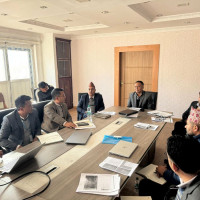- Thursday, 8 January 2026
One Year of Government Special Supplement
Economic Crisis Over, Threats Persist
The Nepali economy experienced an unprecedented slowdown in the last fiscal year 2022–2023, depressing all—the government, private sector, and common people. The government failed to meet the annual targets for revenue and capital budget mobilisation, and there was a gap of about Rs. 432 billion between government receipts and expenditures from the Treasury. The above 7 per cent inflation, which sustained for about one and a-half years, scared the consumers who were suffering from the reduction in income, while a significant number of them lost their savings made at the cooperatives across the country.
This resulted in a fall in demand in the market, which forced the private sector industries to reduce their production capacity. Most of the industries producing consumer goods were running at half of their total capacity, while decreased construction activities sent the market for construction materials to a recession, and industries like cement and steel operated at about a quarter of their installed capacity. A study conducted by the Nepal Rastra Bank (NRB) showed that the industries were utilising only 43 per cent of their capacity. Meanwhile, the government's failure to clear the dues of the private sector in time created another panic.
Although the external sector began to show improvement in the second half of the last fiscal year with measures to control impact and check the flow of foreign currency reserves out of the country, inflation hovered around 7-8 per cent scaring consumers away from the market. The government and the NRB presented the external sector improvement as an improvement in the economy, but the private sector and the public felt otherwise. At the same time, the country witnessed a record outflow of Nepali migrant workers and students.
The private sector has a view that the government as well as other parties to the national economy became apprehensive of the rapid economic expansion in the aftermath of the COVID-19 pandemic, and the government adopted a policy to reduce demand and expenses. These steps only aggravated the problem.
Good news during festivals
However, the end of the fourth month of the current FY 2023/24 has brought some good news to the economy as well as to people. Surprisingly, inflation moderated to 5.38 per cent in mid-November during the festive season, up from 7.5 per cent a month ago and 8.08 per cent a year earlier. The NRB said that the inflation of food and beverage items was 6.01 per cent and that of non-food and service products was 4.89 per cent.
Likewise, the Balance of Payments (BOP) jumped to a Rs. 147.1 billion surplus in mid-November from Rs. 20.03 billion last November. The BOP is the difference between the payments into and out of a country over a given period. The current account (difference between the country's savings and investments) remained at a surplus of Rs. 96.38 billion in the four months, against a deficit of Rs. 37.79 billion in the same period of the previous year.
The country that until mid-July last year was worried about depleting foreign exchange reserves now has Rs. 1696.8 billion in reserves, which is sufficient to cover prospective merchandise imports for 13.6 months and merchandise and services imports for 11.3 months, according to the statistics of the central bank.
Meanwhile, export trade is still struggling to regain its earlier momentum. Although the fall in exports came down to 6.09 per cent in the first five months of this year against a nose-dive of 33.33 per cent last year, the size of exports is still about Rs. 4 billion below last year's mark.
After a year in office under the leadership of Pushpa Kamal Dahal 'Prachanda,' the government has successfully steered the economy towards a more favourable position.
With the correction in bank interest rates, business activities and job creation are expected to grow. Meanwhile, Prime Minister Prachanda's initiative to enhance dialogue with the private sector and increase the latter's confidence is noteworthy. He claimed that the government has gained success in maintaining the stability of the financial sector, and improvements have been seen in the investment environment.
In mid-December, the average base rate of banks came down to a single digit of 9.74 per cent from 10.6 per cent a year earlier, while the interest rates on loans moderated to 11.96 per cent from 12.65 per cent.
The government has approved a Rs. 71.25 billion investment in one year of PM Prachanda's tenure. In the meantime, the Investment Board of Nepal issued a licence for the survey for the 750-megawatt West Seti and 450-megawatt Seti River-6 hydropower projects. Progress at Arun III and other infrastructure projects is satisfactory. However, the operation of the recently built international airports in Bhairahawa and Pokhara is not satisfactory. The government has also announced plans to hold an investment summit next year to showcase the country's large projects and attract foreign investment.
Remittances continue to soar
Remittances, the backbone of the Nepali economy and the largest source of foreign currency income, continue to soar, with an increment of 26.4 per cent in the inflow of Rs. 477.96 billion. Last year, there was an increase of 20.4 per cent in remittance inflow. A couple of years ago, the country was on the verge of the Sri Lankan crisis, not having enough money to finance the import trade and service the country's loans.
However, increasing muscle and brain drain is worrisome. In the first four months of this year, the number of Nepali workers, both institutional and individual, taking first-time approval for foreign employment stands at 137,475 and taking approval for renewing entry stands at 68,841. It is less than last year's 196,735 and 87,428, respectively. Amidst the economic depression, more than 750,000 Nepalis left the country for foreign employment in 2022/23. To check the outmigration of youth and obtain their contribution to the country's growth and development, business and investment should be promoted, and more employment should be generated within the country. For this, the confidence of the private sector should be boosted through better performance at capital budget mobilisation and the execution of business-friendly policies and incentives.
At the same time, tourist arrivals by air crossed 108,600 in November, following the trend in October, a major tourist season in Nepal, when 117,306 tourists arrived here. These statistics showed that the country has gained the same momentum in tourism as before the COVID-19 pandemic.
Improved capital spending
The government's performance in utilising the budget allocated for development work has improved this year. By Saturday, December 23, this year, utilisation of the capital budget stood at 12.51 per cent (Rs. 37.7 billion) of the total allocation of Rs. 302 billion. Last year, by the same time, only 9.92 per cent of capital allocation was used; however, in terms of amount, it was the same: Rs. 37.7 billion of Rs. 380.3 billion.
Improved capital spending means better performance at development projects and more jobs for private sector businesses like construction, transportation, and human resources companies, as well as cement, iron bar, and other construction material producers. These activities help to generate employment, mobilise the market, and contribute to the economic growth of the country. Since the monsoon and festival seasons are over now, the government should put more effort into spending the development budget and expediting development and public construction.
Meanwhile, the government has to devise a strategy to increase revenue collection. The widening gap between revenue and expenditure might again repeat the situation where the government fails to pay the money to the construction companies, and development works are affected.
(The author is a journalist at The Rising Nepal)












-original-thumb.jpg)



